Identity Broker Forum
Welcome to the community forum for Identity Broker.
Browse the knowledge base, ask questions directly to the product group, or leverage the community to get answers. Leave ideas for new features and vote for the features or bug fixes you want most.

 Sometimes Changes Sync doesn't run when there are pending changes
Sometimes Changes Sync doesn't run when there are pending changes
In UNIFYConnect very occasionally Change Sync won't run (either from a schedule or when invoked manually from the UI) when there are pending changes on the link. Service restart doesn't help, but running a Baseline Sync does. I have no idea what causes it to get into this state I'm afraid.

 Changes register item processing on connector failed with reason Cannot process a DateTime of type 'Unspecified'
Changes register item processing on connector failed with reason Cannot process a DateTime of type 'Unspecified'
The error Changes register item processing on connector TechOne Person failed with reason Cannot process a DateTime of type 'Unspecified' is logged for an adapter which has a join to another connector with a Timestamp field that was populated by PowerShell when that adapter's base connector imports a new or updated entity, even when that Timestamp field has DateTime kind 'Utc' or 'Local'.
My config has two PowerShell connectors, TechOne Person and TechOne Position. The Position connector has two fields StartTimestampUTC and EndTimestampUTC which are set to valid DateTime values, of kind 'Utc'. There is one adapter, TechOne Person, for which the Person connector is a base, and the Position connector is a Join transform with StartTimestampUTC and EndTimestampUTC fields both mapped into adapter fields.
When a new record is present in the Person connector import, reflection causes the above error message to be logged, but the adapter record is created correctly nevertheless. When a subsequent Generate Changes is run on the adapter, the error is not logged. If the record is reimported with updated values, the error is logged.

 Chris21 agent rejecting server certificate even when set to None: "remote certificate is invalid according to the validation procedure"
Chris21 agent rejecting server certificate even when set to None: "remote certificate is invalid according to the validation procedure"
My customer is seeing this error, even though Handle Certificate Errors is set to "None":
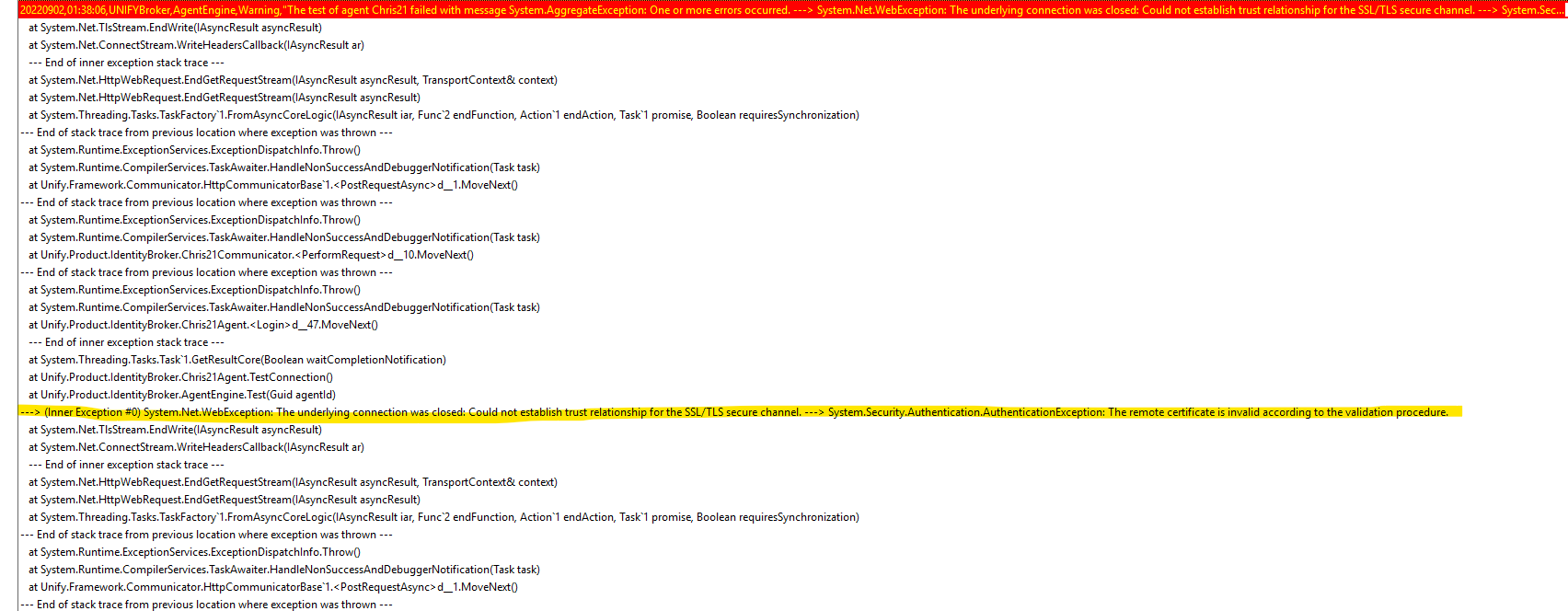
Here's the config:

Port 80 without SSL works fine, with an otherwise identical configuration.
In case it's relevant, the connection to Chris21 is via a UNIFYConnect PortBridge tunnel on a non-standard IIS port number (444). It's not possible to use port 443 due to restrictions on the customer side.

This has been implemented and is available in the release of UNIFYConnect V6, which will be made available shortly.

 How do I identify the Chris21 endpoint URI?
How do I identify the Chris21 endpoint URI?
I am trying to connect to a new customer's Chris21 instance (via PortBridge, just to make it more complicated) and they don't appear to have a "Scalable/c21connect.asp" endpoint in their Chris21 install. How do I work out what URI to use instead?

I was able to find the endpoint by going to the Chris21 web server's IIS, Exploring the web site and finding the path to the file called c21connect.asp.

 Where does the HPRM connector source its schema from?
Where does the HPRM connector source its schema from?
Hi Team,
We are currently experiencing an issue with a HPRM Associations Connector where by the schema has seemingly updated automatically and changed the Key attribute's (Uri) required value to 'false'. It also seems the field is locked (see in the below image) so it cannot be manually overridden to put the connector back in a working state.
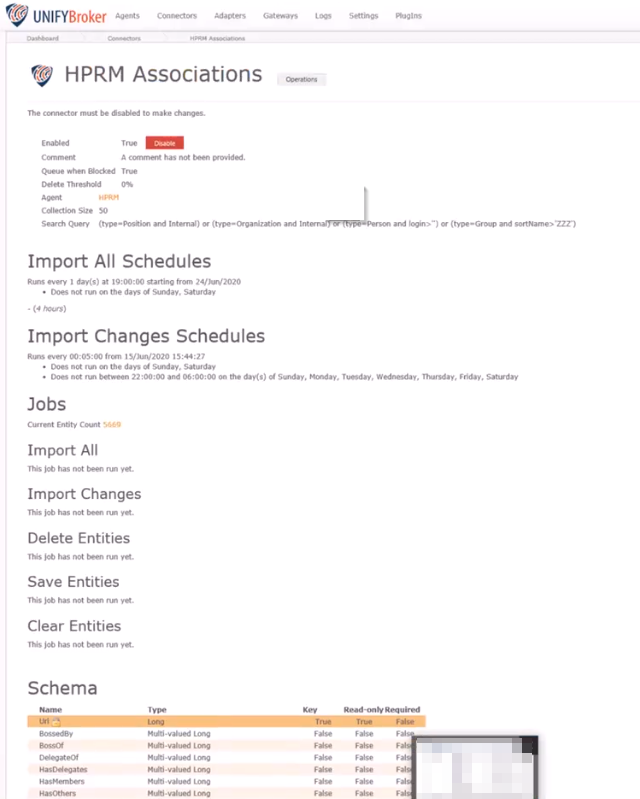
This then, as a result, breaks the corresponding Adapter as the Uri field is used as a part of the DN. Broker provides the following error in the logs:
"
An error has occurred: Error in adapter HPRM Associations distinguished name configuration: The DN component part 'CN=[Uri]' could not be executed as the field Uri is not required. An empty field would result in a DN of 'CN='.
full error:
System.Exception: Swagger Exception could not be parsed. SE response code: 500; SE response text: {"Message":"An error has occurred.","ExceptionMessage":"Error in adapter HPRM Associations distinguished name configuration: The DN component part 'CN=[Uri]' could not be executed as the field Uri is not required. An empty field would result in a DN of 'CN='.","ExceptionType":"Unify.Framework.UnifyConfigurationException","StackTrace":" at Unify.Product.IdentityBroker.AdapterEngine.ValidateAdapterForEnabling....
"
Checking the UAT environment, I can see that the HPRM Associations connector still has the Uri field's required value set to true.
I can see the fix for this particular issue would be fix the source for wherever the schema is being drawn from. So I'm looking to see if you could tell me where the Connector is getting the schema from. In addition as it seemly committed a modification to the schema from the source without a user committing it through the GUI, would you be able to elaborate on when the connector commits changes to the schema?
Thanks in advance

 High CPU usage for UNIFYBroker service while nothing is running
High CPU usage for UNIFYBroker service while nothing is running
Hi Team,
A customer has reported high CPU usage for the UnifyBroker service coming to me initial with the following report:
"In the past month we have been getting High CPU (90%) usage of the UnfyBroker service. We are using version v5.3.3. There has been no change in the environment other than the normal Microsoft patches once a month. It is occurring on both our prod and uat environments."
Confirm some further details with the customer I got the following spec information on the hosts and details about the behaviour:
"Specs on the servers.
Name Memory vCPU OS
PRD 16Gb 4 2016
UAT 14Gb 4 2016
Processor type - Intel(R) Xeon(R) Gold 5118 CPU @ 2.30GHz, 2295 Mhz, 1 Core(s), 1 Logical Processor(s)
The high cpu is more often on the uat server which processes the same data as prod for new accounts but the changes during the day are very minimal. The cpu usage does come down after
The utilization in some instances has cleared itself. Some have been by stopping the service. Timing is from 10 mins to an hour for uat. Interestingly on the prd server the time has been for several hours."
Some initial adjustments were made to the scheduler to ensure nothing is overlapping, though this wasn't really happening much anyway. These adjustments did not see any improvement to the situation.
Additionally the customer reported back the entity counts in the connectors to get a gauge for the size of the environment:
"Connector Prod Uat
Employee CSV 10792 10792
Position CSV 10792 10792
Teams 14805 1035
AD 45683 51356
Adapters
Person 10792 10792
Position 10792 10792"
Looking at the extensibility for the setup there are a number of powershell transform in the environment, which may explain some high cpu usage while connectors or running, though doesn't seem to explain why the high cpu usage continues afterwards.
Finally the following resource monitor screenshots were provided to see what is consuming the resources for the service while no connectors are running:
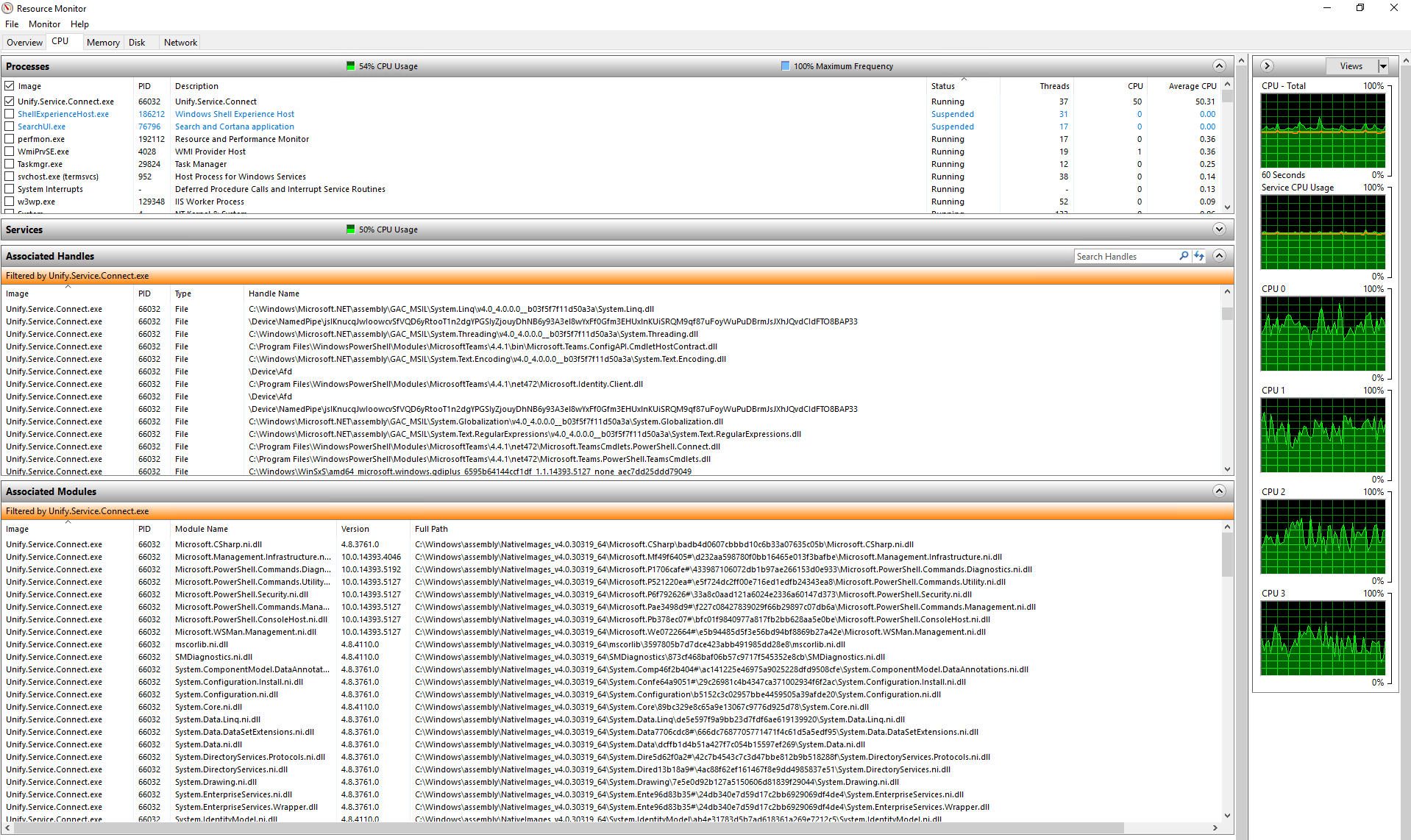
I have confirmed no out of bounds scripts are contacting the service. And that there aren't a large number of WebUI sessions open that could be causing issues. So I am looking for the next steps in troubleshooting this one. Are you able to provide any guidance in figuring out what could be consuming the resources like this?
Let me know if there is any further information I can provide you.
Thanks in advance

This should be resolved with UNIFYConnect V6, with significant improvements to database connectivity, reflection performance, updated powershell versions and improvements in the underlying .net framework.
This can be revisited if the problem can be reproduced on the new version.

 SCIM gateway attribute update comes through as XML document
SCIM gateway attribute update comes through as XML document
An update from Azure via the SCIM gateway is being passed through to the adapter as a large XML document, as shown in this UNIFYBroker PowerShell log entry in a reverse adapter transform:

Before this SCIM update was received, the JobTitle field in the adapter for this user was NULL. After the export update was received and processed the field in the adapter contained the XML document content. Here is what the Azure POD showed:
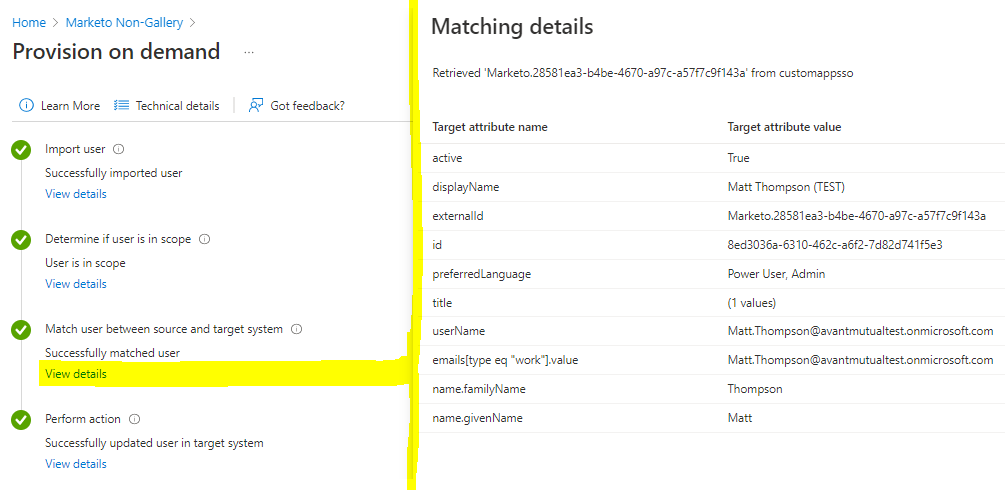
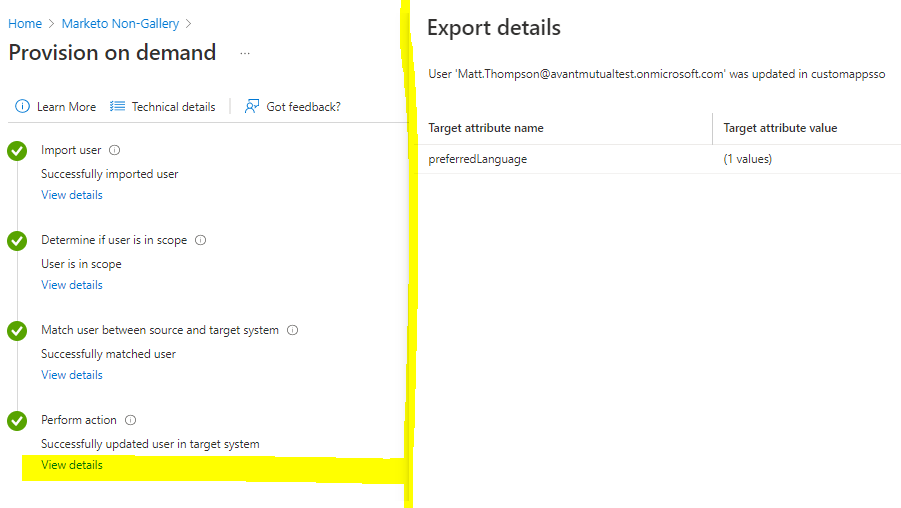
According to Azure, it doesn't appear to be updating the title SCIM attribute (which ismapped to the JobTitle adapter field) at all, but nevertheless UNIFYBroker is populating it with XML document content by the time it gets to the adapter reverse transform.
Here's the adapter reverse transform (which doesn't do anything with JobTitle) showing the logging code:
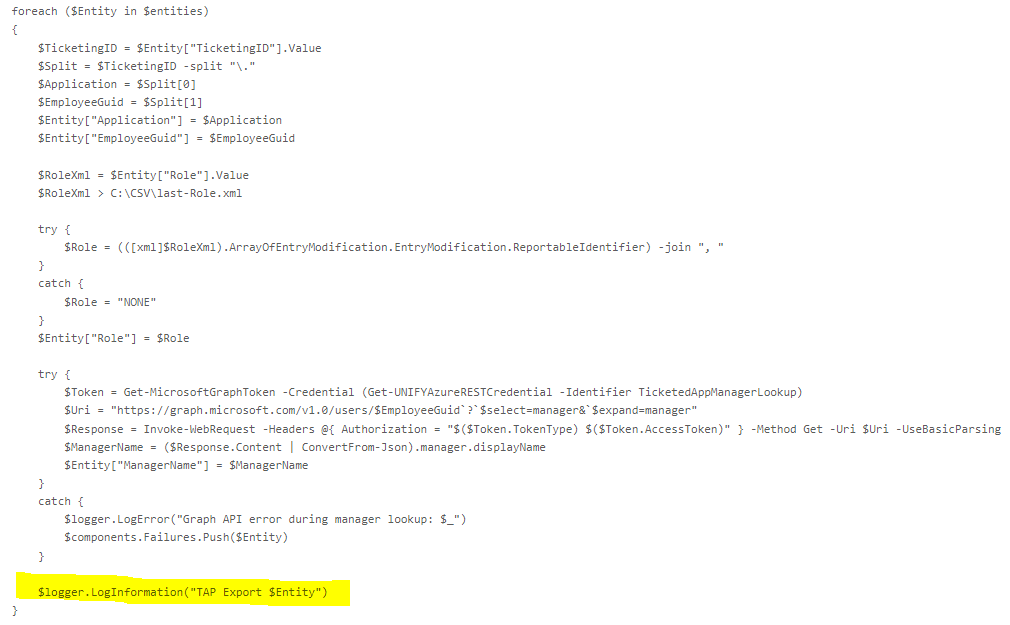

 Support for multi-valued attribute in the SCIM gateway
Support for multi-valued attribute in the SCIM gateway
I am looking into getting multi-role support for Azure App Provisioning with UNIFYBroker following the process described on this page: https://docs.microsoft.com/en-us/azure/active-directory/app-provisioning/customize-application-attributes#provisioning-a-role-to-a-scim-app
Specifically, I’m using the ‘AppRoleAssignmentsComplex’ case, because some customers need the multi-role scenario (i.e. users can be assigned to multiple roles for the same app).
To make this work Azure needs to use a SCIM attribute that supports multi-values (see ‘Example output’ for a non-normative example).
Are there any multi-valued attributes in the current UNIFYBroker SCIM gateway implementation that I can use for this?
If not then is it possible to implement one using the current SCIM library, or will it only be possible once the SCIM gateway is ported across to a different DLL?

This has been implemented and is available in the release of UNIFYConnect V6, which will be made available shortly.

 CSV connector fails all add entities during data load if the file doesn't exist
CSV connector fails all add entities during data load if the file doesn't exist
I'm doing data load in a new environment and an export CSV didn't exist before I ran Add Entities to populate it. Since the file didn't exist the connector is failing the entity adds and the log file is now filling with one error for each entity, which has made the system unusable for over 5 minutes. If I had more like 100,000 records to write out this could delay the data load activity for an hour or more.
While not a show-stopper (I've now created a CSV file with headers and no data and re-run the Add Entities operation) it's annoying and I don't see why the file can't simply be created if it doesn't exist.

 Duplicate Adapter IDs in extensibility clear the extensibility file on failed service start
Duplicate Adapter IDs in extensibility clear the extensibility file on failed service start
Hello Team,
I understand editing the service extensibility config directly is not supported/recommend, and therefor this issue shouldn't be expected to impact any environments under normal circumstances. However I found some interesting behaviour that occurs when an AdapterConfiguration object in the Unify.Product.IdentityBroker.AdapterEnginePlugInKey.extensibility.config.xml file is given a duplicate "AdapterId".
When attempting to start the service with an incorrect configuration like this, the service fails to start which is expected, however the entire Unify.Product.IdentityBroker.AdapterEnginePlugInKey.extensibility.config.xml file is also cleared and saved in the process. Clearing any other configuration that may be there. I'm unsure if this is intended behaviour, but figured I would log this here anyway for your consideration so the service would simply fail and not save over the configuration.
UNIFYBroker version 5.3.1
Thanks

Due to significant changes in config handling and format, UNIFYConnect V6 behaviour will remove the subsequent entry and save the file with the new config, rather than removing the entire contents of the file.
Customer support service by UserEcho

